Introduction
Here are some examples of exercises for you to try. The exercises may be suggested for a condition or for rehabilitation. Start each exercise slowly. Ease off the exercises if you start to have pain.
You will be told when to start these exercises and which ones will work best for you.
How to do the exercises
Cat-cow
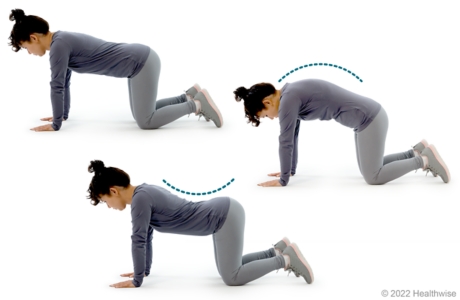
- Get on your hands and knees. Your shoulders should be directly above your wrists, and your hips should be above your knees. Your back should be flat, and your neck should extend straight out from your spine. Your gaze should be toward the floor below.
- Relax your head and allow it to droop. Round your back up toward the ceiling until you feel a nice stretch in your upper, middle, and lower back. Hold this stretch for as long as it feels comfortable, or about 15 to 30 seconds.
- Then let your back curve down by pressing your stomach toward the floor. Lift your buttocks toward the ceiling. If it doesn't bother your neck, you can raise your head as you allow your back to sway. Hold this position for 15 to 30 seconds.
- Go back and forth smoothly 2 to 4 times between the rounded back and swayed back positions.
If you have a neck problem or injury, keep your neck in the original position in line with your torso instead of moving it with your spine.
Chest expansion
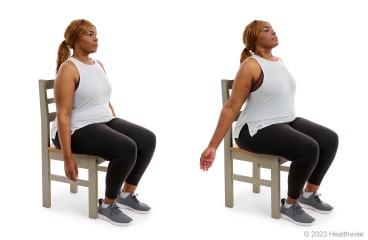
- Sit or stand up straight with your feet shoulder-width apart.
- Look straight ahead, and do not allow your head to tilt back. As you take a deep breath, open your arms out to the sides and roll your arms back. Your palms will turn outward, and you will feel a stretch across your chest.
- Hold this stretch for 15 to 30 seconds. Keep breathing normally and don't hold your breath.
- Slowly lower your arms to your sides and let your palms turn back toward your legs.
- Repeat 2 to 4 times.
Overhead stretch
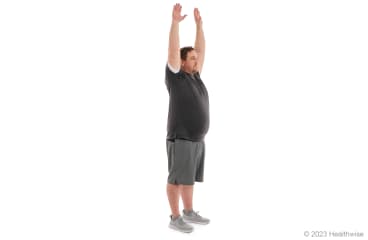
- Stand up straight with your feet shoulder-width apart. Or sit up straight in a chair.
- Looking straight ahead, raise both arms over your head. Reach up and back with your arms until you feel a stretch in your shoulders. Do not allow your head to tilt back.
- Hold for 15 to 30 seconds, then lower your arms to your sides.
- Repeat 2 to 4 times.
Neck rotation
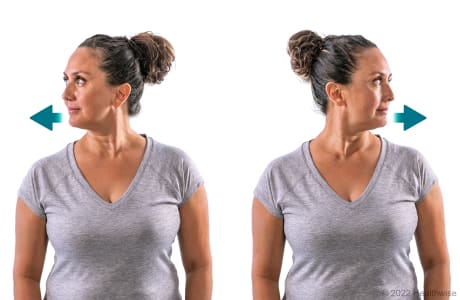
- Sit up straight in a firm chair, or stand up straight. If you're standing, keep your feet about hip-width apart.
- Keeping your chin level, turn your head to the right and hold for 15 to 30 seconds.
- Turn your head to the left and hold for 15 to 30 seconds.
- Repeat 2 to 4 times.
Neck stretch to the side (upper trap stretch)
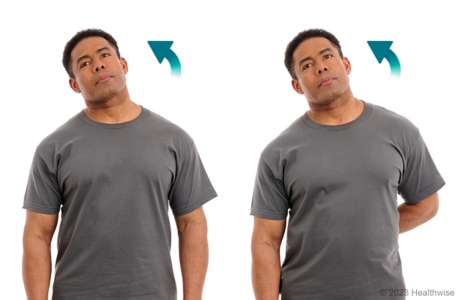
- Sit in a firm chair, or stand up straight. Keep your shoulder down as you lean away from it. To help you remember to do this, start by relaxing your shoulders and lightly holding on to your thighs or your chair.
- Look straight ahead. Tilt your head toward one shoulder and hold for 15 to 30 seconds. Relax and let the weight of your head stretch your muscles.
- Slowly return your head to the starting position.
- Repeat 2 to 4 times toward each shoulder.
If you would like a little added stretch, place your arm behind your back. Use the arm opposite of the direction you are tilting your head. For example, if you are tilting your head to the left, place your right arm behind your back.
You can also add more stretch by using one hand to pull your head toward your shoulder. For example, keeping your right shoulder down, lean your head to the left and use your left hand to gently and steadily pull your head toward your shoulder.
Press-up back extension
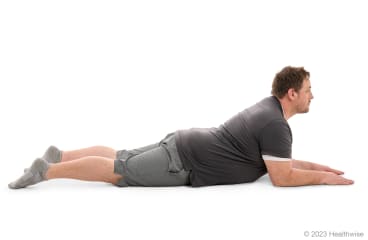
- Lie on your stomach, supporting your body with your forearms. Keep your elbows below your shoulders.
- Press your elbows down into the floor to raise your upper back. As you do this, relax your stomach muscles and allow your back to arch without using your back muscles. Don't let your hips or pelvis come off the floor.
- Hold for 15 to 30 seconds, then relax.
- Repeat 2 to 4 times.
Alternate arm and leg (bird dog)
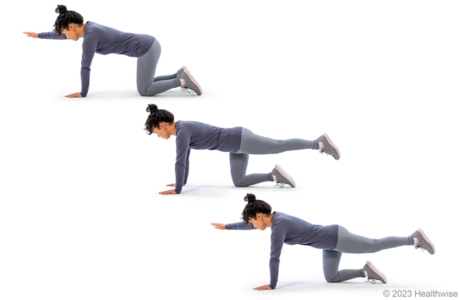
- Start on the floor, on your hands and knees.
- Tighten your belly muscles by pulling your belly button in toward your spine. Be sure you continue to breathe normally and do not hold your breath.
- Keeping your back and neck straight, raise one arm off the floor and hold it straight out in front of you. Be careful not to let your shoulder drop down, because that will twist your trunk.
- Hold for about 6 seconds, then lower your arm and switch to your other arm. Over time, work up to holding for 10 to 30 seconds each time.
- Repeat 8 to 12 times with each arm.
When you feel steady and strong doing this exercise with your arms, try doing the exercise with your legs instead. Raise one leg and hold it straight out behind you. Be careful not to let your hip drop down, because that will twist your trunk.
When holding your leg straight out becomes easier, try raising your opposite arm at the same time.
Current as of: July 31, 2024
Author: Ignite Healthwise, LLC Staff
Clinical Review Board
All Ignite Healthwise, LLC education is reviewed by a team that includes physicians, nurses, advanced practitioners, registered dieticians, and other healthcare professionals.

